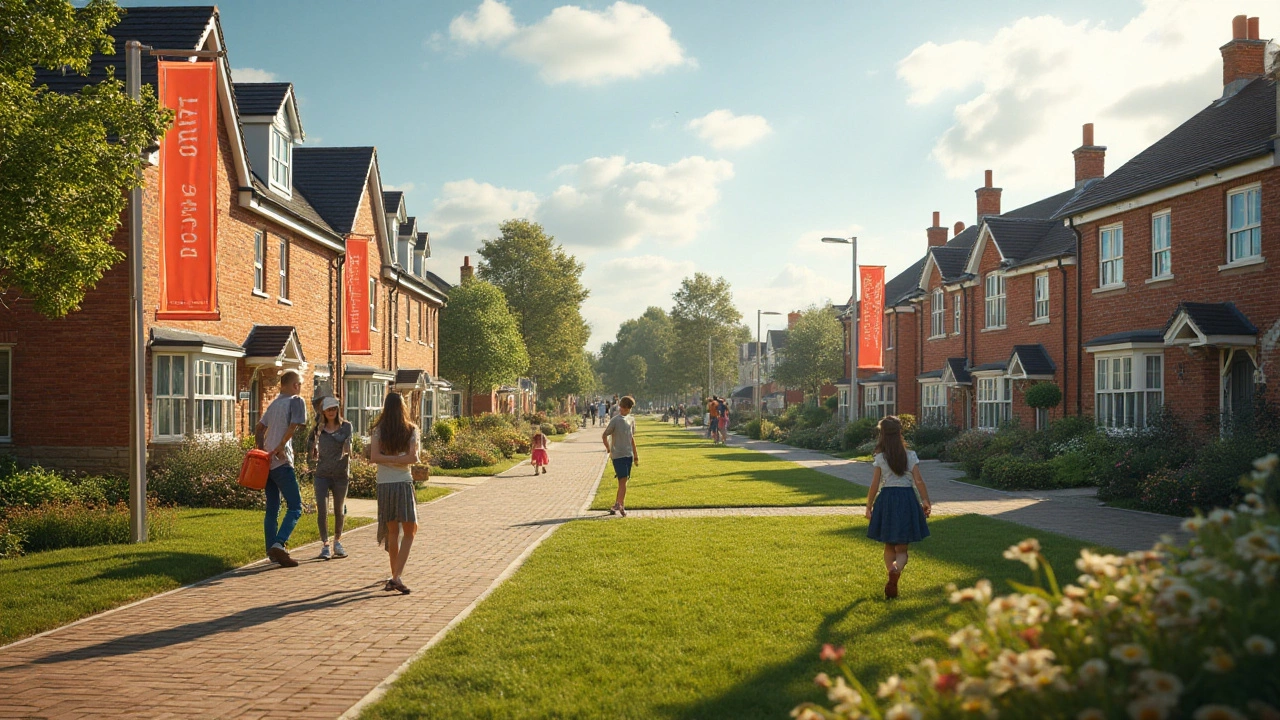Benefits of Shared Ownership Homes: A Comprehensive Guide
 Jan, 19 2025
Jan, 19 2025
In today's bustling property market, owning a home may seem like a distant dream for many. However, shared ownership offers a promising and viable solution. This approach makes it possible to step onto the property ladder by buying a share of a home, while renting the remainder.
Understanding the benefits and opportunities of shared ownership can open doors that seemed previously closed. It's about finding a balance between owning and renting, with the added bonus of having the potential to increase your stake in the property over time.
This article delves deep into how shared ownership works, the financial perks it offers, and why it might be the right choice for you. Let's explore how this path not only helps in securing a home but also fosters a sense of community and belonging.
- Understanding Shared Ownership
- Financial Benefits
- Pathway to Full Ownership
- Community and Lifestyle Advantages
Understanding Shared Ownership
The concept of shared ownership can be likened to a bridge between renting and buying a house outright. It offers the opportunity to buy a portion of a property, typically between 25% and 75%, and pay rent on the remaining portion. This two-fold payment system allows buyers to secure a home with a smaller deposit, making it an enticing option for those daunted by the traditional property market. Crucially, this model helps individuals start their housing journey, which can seem out of reach in many bustling urban centers.
Introduced in the UK in the early 1980s, shared ownership was designed as a government initiative to assist people in gaining housing stability. Today, this concept remains a popular choice with thousands of properties purchased through this scheme each year. According to a National Housing Federation report, there are over 200,000 shared ownership homes in England alone. Often facilitated by housing associations and developers, shared ownership agreements come with clearly outlined terms that prospective buyers should thoroughly review. This scheme is predominantly targeted towards first-time buyers, although certain areas also support this model for other buyers.
"Shared ownership represents a cultural shift in how we approach property ownership, offering flexibility and accessibility, especially during uncertain economic times." – Housing Expert, Claire Reynolds
The process resembles any property purchase; however, eligibility criteria can vary. Typically, shared ownership is open to households earning less than a designated amount annually, with priority often given to local residents. Potential buyers, after expressing interest, need to pass an eligibility assessment, ensuring both financial capability and stability. By purchasing a share, occupants become leaseholders, their interests legally protected under leasehold law. Importantly, shared ownership offers the opportunity to 'staircase,' meaning increasing your share of the property over time, potentially leading to full ownership.
While shared ownership is beneficial, it isn't without its complexities. Potential buyers must consider extra costs like service charges, which cover maintenance of communal areas and can add up significantly over time. Research by the Chartered Institute of Housing highlights these associated costs as a common concern among shared owners. The dual nature of ownership – half owner, half tenant – means certain restrictions on home modification might apply without the freeholder's consent. Yet the security and autonomy this framework offers often outweigh these considerations for many. As the property market evolves, shared ownership continues to provide a valuable pathway to home ownership for those willing to navigate its unique challenges and rewards.

Financial Benefits
When you think about buying a home, the burden of a hefty mortgage often springs to mind. With shared ownership, this worry is significantly reduced. Entering the housing market becomes more accessible, as you only need to secure a mortgage for the share you are purchasing. This typically results in a much lower deposit compared to traditional property purchases, making it an appealing option for first-time buyers or those with a limited budget.
A key advantage of the shared ownership model is that it allows individuals to enjoy the benefits of home ownership without the associated financial strain. Monthly payments, combining both mortgage and rent, are often more affordable than full market rent or mortgage installments. This financial flexibility is a lifeline for many, offering a cost-effective way to enjoy the security and stability of owning a home, while simultaneously keeping other lifestyle options open.
The appeal of shared ownership extends beyond just lower costs. It's an opportunity to incrementally increase your share in the property over time, known as 'staircasing'. As you increase ownership, the amount of rent you need to pay decreases, leading to significant financial savings in the long run. Over the years, this gradual path to full ownership can work against inflation, as house prices typically rise. Steve Bolton, a property expert, once said,
"Shared ownership schemes essentially offer a safeguard against the volatile property market, allowing new buyers a foothold without risking everything."
In today's economic climate, taking advantage of the financial benefits of shared ownership can reap substantial rewards. For instance, data from the UK shows that shared owners typically spend less than a third of their income on housing costs, compared to renters who might spend as much as half. These savings could be redirected towards other financial goals, such as savings, investments, or travel.
| Average Monthly Expenditure | Shared Ownership | Full Rent |
|---|---|---|
| Housing | $800 | $1200 |
| Utilities and Maintenance | $150 | $200 |
| Monthly Savings Potential | $250 | $0 |
By securing your own piece of property, even if just a fraction, you’re setting the groundwork for building equity. This equity not only acts as a safety net for unforeseen expenses but also serves as a financial asset for future endeavors or retirement. Unlike renting, where monthly payments offer no long-term benefit, the shared ownership model allows you to contribute to something tangible and valuable.

Pathway to Full Ownership
Embarking on the journey of shared ownership is much like setting sail with a clear horizon in mind—the transition to full ownership. It's not just about acquiring a share of a property, but the incremental steps towards making that property entirely yours. This pathway provides peace of mind by offering a structured and achievable plan. Participants in shared ownership agreements typically have the right to increase their stake in the property gradually through a process known as 'staircasing'. This involves purchasing additional shares, often in increments of 10%, as financial conditions permit.
The beauty of staircasing is the flexibility it affords. It allows individuals to adapt to their evolving financial means. For instance, when a person's salary increases or other financial resources become available, they can opt to buy an additional share. The ultimate dream of owning the entire property is thus brought within reach, step by manageable step. This sustainable model caters to different income levels and life stages, easing the pressure of large, immediate financial commitments. According to the Office of National Statistics in the UK, shared ownership increases housing affordability, providing a route for young professionals who otherwise may be locked out of the traditional property market.
"Shared ownership isn't just a buying option; it's a progression opportunity," says Marcus Shields, a property economist. "It bridges the gap between renting and full ownership, particularly in expensive urban areas."As one continues to staircase, their rent proportionately decreases, making the path to home ownership not only possible but practical. Moreover, appreciation of property value works in favor of the shared owner. As the property value increases, the equity of the owner's share rises, enhancing their financial portfolio. Many find such strategic investing beneficial, allowing assets to grow with time.
It is, however, essential to consider certain costs associated with staircasing. Legal fees and possible loan arrangements come into play here, as well as costs for property valuation each time a share is bought. Nonetheless, the advantages of eventually eliminating rent can outweigh these considerations. It’s like planning a long trek with several resting points, where each stop brings you closer to your destination. In some regions, shared owners can eventually sell their share at market value, potentially even capitalizing on property appreciation. This buying and selling mechanism further strengthens the investment aspect of property ownership.
For those contemplating this path, close collaboration with housing associations and financial advisors is recommended to map out a personalized path to full ownership. This journey, although requiring patience and careful planning, exemplifies a robust strategy in today's ever-volatile housing market. With shared ownership, individuals are not merely buying property; they are investing in their future—and one step at a time, they are building solid ground from where dreams of homeownership bloom and become a tangible reality.
| Year | Percentage of Ownership | Average Property Value Increase (%) |
|---|---|---|
| Year 1 | 25% | 3% |
| Year 5 | 50% | 15% |
| Year 10 | 100% | 30% |

Community and Lifestyle Advantages
Shared ownership isn't just about possessing a piece of property; it also weaves the fabric of a thriving community. By choosing shared ownership, you're joining a network of like-minded individuals who have opted for the same model. This shared interest cultivates a strong community spirit, sometimes akin to what you might find in established neighborhoods. It moves beyond the solitary nature of traditional home ownership, inviting people into a collective journey. Many shared ownership homes come with built-in community spaces that encourage interaction, bonding, and shared activities, infusing a sense of belonging that's especially valued in today's fast-paced world.
One notable aspect is how shared ownership contributes to a vibrant, diverse community. With an approachable entry point into the housing market, it's accessible to a wide range of individuals and families. This diversity enriches the community atmosphere, fostering a dynamic environment. Statistics suggest that diverse communities often experience stronger social ties and economic growth, enhancing the lifestyle of its residents considerably. Moreover, local amenities like parks, playgrounds, and shopping centers frequently cater to these communities, ensuring every resident finds daily life both convenient and enriching.
Beyond the social fabric, the lifestyle benefits of shared ownership cannot be overstated. Those who opt for shared ownership often report a greater sense of security. Knowing that part of the property is theirs, homeowners feel a stable, long-term investment in their residency. This sense of financial stability often translates into more profound peace of mind, contributing positively to mental well-being. A shared owner from a prominent Sydney community once articulated, "It's deeply comforting knowing that my home is my safe space, and my neighbors are like family." Such testimonials reflect the broader satisfaction shared ownership can bring.
The strategic location of shared ownership homes can also provide unique lifestyle benefits. Many of these properties are situated in areas undergoing development, offering residents a front-row seat to the evolution of their surroundings. This can mean greater access to new infrastructure, such as improved transportation links and cultural revamps. Consequently, property values in these areas often see rewarding appreciation over time. Imagine living in a place where the city or town continuously strives to enhance the quality of life. It's an exciting prospect that many shared ownership residents experience.
Shared ownership homes frequently feature sustainable designs and energy-efficient technologies, adding to lifestyle benefits. Many shared ownership projects emphasize environmental responsibility, often incorporating sustainable materials and energy-saving technologies. These green features not only lead to cost savings on utilities but also create a healthier environment for residents. Living in homes that are designed with the planet in mind is an advantage that resonates well with the contemporary ethos of responsible living. This approach naturally aligns with the community's collective mindset—making a significant contribution to reducing carbon footprints along the way.